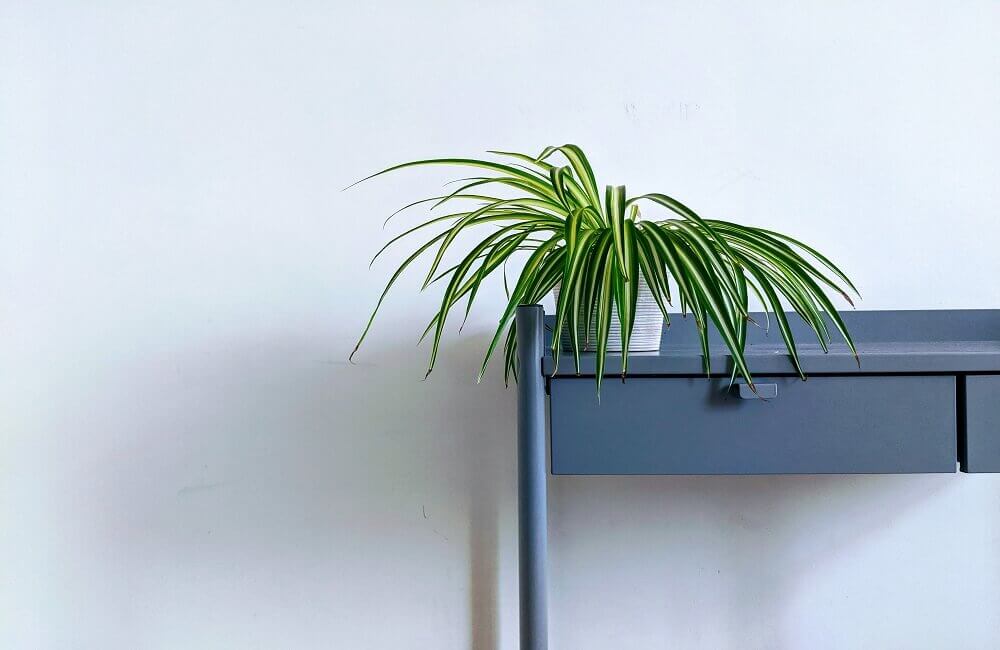
A favorite among the houseplant owners for ages due to their stylish and elegant appearance, spider plants are also among the easiest houseplants to grow. Spider plants are named as such because of the way the plantlets or spiderettes dangle from the mother plant like a spider dangling from its web. These give a cascading appearance, especially when grown as hanging plants or even when placed atop columns.
Scientifically known as Chlorophytum comosum, spider plants are evergreen, perennial plants. Native to South Africa, spider plants have elongated leaves that are linear or lance-shaped and their stems are slender. They flower regularly with the flowers appearing at the tips of leafless stems. The flowering can be in raceme or panicle form bearing several small white flowers. It is through the transformation of the flowers that the multitude of spiderettes is formed.
Spider plants are also known by many different names, with the most common name being “airplane plant” due to their hanging appearance. Other names include spider ivy, Bernard’s lily, or ribbon plant.
Table of Contents
Spider Plant Brief Summary:
Family: Asparagaceae
Botanical Name: Chlorophytum comosum
Sunlight: Partial Shade
Exposure: Sheltered
Soil Type: Loamy, moist but well-drained
Soil pH: Acid, Alkaline, Neutral
Plant Type: Perennial houseplant
Flower: White flowers
Flowering Frequency: Regularly flowers
Height: Up to 12 inches
Width: Up to 24 inches
Toxicity: Nontoxic
Different Varieties of Spider Plants:
Including the solid green-leaved Chlorophytum comosum, you can find a great many varieties of spider plants that you can choose from to grow in your house. Many unique cultivars of spider plants, each differing from the other either in their degrees of variegation, the shape of their leaves, or their texture, are available. Here is a list of some of the varieties and cultivars of spider plants:
Chlorophytum comosum ‘Bonnie’:
This variety of spider plants has loosely curled leaves that may also appear twisted. The leaves feature a cream center stripe with green margins. Chlorophytum comosum ‘Bonnie’ is also more compact than the main spider plant species.
Variegated ‘Bonnie’ Spider Plant:
Another variation of the Chlorophytum comosum ‘Bonnie’ is the variegated ‘Bonnie’ spider plant. These have green curled leaves featuring creamy white stripes.
Chlorophytum comosum ‘Variegatum’:
With long green stems, Chlorophytum comosum ‘Variegatum’ spider plant has a cream or white color on the leaf margins and a dark green stripe right down the center.
Orchid Spider Plant:
Chlorophytum orchidastrum or orchid spider plant is unique among the spider plants. It features an orange leaf stem and dark green lance-shaped leaves, which gives it its other name, the ‘Green Orange’ spider plant.
Chlorophytum comosum ‘Vittatum’:
Featuring bright green leaves with white middle stripes, Chlorophytum comosum ‘Vittatum’ spider plants have long white stems. The stripes appear in varying widths, from a narrow band to cover the entire leaf width.
Chlorophytum viridescens ‘Hawaiian’:
This variety of spider plant features young leaves which are variegated green and white in color. As Chlorophytum viridescens ‘Hawaiian’ spider plant gets older, the leaves fade to all green. This gives the spider plant a striking multi-colored appearance.
Chlorophytum laxum ‘Zebra Grass’:
The leaves on Chlorophytum laxum ‘Zebra Grass’ spider plant are straight, green, and long with edges marked in white color.
How to Choose the Best Soil for Spider Plants?
The right soil forms the basis for the right nutrition your spider plant will receive, which in turn will decide its proper growth. How do you know which type of soil is best suited for spider ivy? There are a few things you need to check out in order to ascertain the best soil for your spider plants.
1. It Should Be Nutrient Rich:
Spider ivy plants need more nutrients in their soil as they are heavy root feeders. Without enough nutrients in the soil, you will find your spider plants showing no signs of growth. To increase the nutrient content a handful of compost or worm castings into the soil is needed.
2. Drainage Capability:
Sandy soil drains water well while garden soil drains really slow. Both of these aren’t ideal for spider plants. They need a soil type that has good drainage capability but not to the point of drying out soon.
3. Moisture Retention Capacity:
The ideal soil type for spider plants also needs to have a good moisture retention capacity. A well-draining soil that can also retain the moisture long enough to nourish the spider plant is the best option.
4. Aeration:
Another crucial factor is the aeration of the soil. Spider plants cannot thrive if the soil is tightly packed. Adding perlite or pumice to the soil mixture can help provide aeration to your spider plant.
What Kind of Soil is Best for Spider Plants?
Spider plants are known to grow in a variety of soil types, but they grow best in a nutrient-rich, loamy soil. Neutral soil pH is ideal for spider plants. However, they are able to tolerate slightly acidic or alkaline soil as well. Care must be taken to ensure that there isn’t a high level of salt in the soil as it can lead to the leaf tips turning brown. It is also best to avoid using garden soil for your spider plant. Most garden soils are too heavy and may lead to water retention issues, hampering the growth of the plant.
What are Loamy Soils?
Loamy soils are friable, meaning they have a texture that is loose and crumbly. This also helps in aeration in addition to providing ease of growth to the roots. Loamy soil consists of a mixture of clay, sand, and silt or humus. Clay is rich in nutrients and retains water well. Sand is well-draining with not many nutrients. Silt has better retention of moisture but with fewer nutrients compared to clay, while humus is a partly or completely decomposed organic matter which helps make the soil more friable. Thus, making loamy soil perfect for growing spider plants.
Can You Create Loam for Your Garden?
Yes, you can create loamy soil. However, creating loamy soil isn’t a one-time thing. It is an ongoing process that involves adding organic matter into the soil. Finding out the soil type in your garden is advantageous to creating better loamy soil, which can be done through a soil test. If you find that your soil is too sandy or extremely heavy clay, a lot of organic matter needs to be added each season or multiple times in a season. This is because organic matter can get depleted quickly due to decomposition. For most soil types, you can add a layer of about 2-inch thick organic matter on the surface and then mix it into the soil.
Fertilization of Your Spider Plants:
Caution is needed when it comes to fertilizing your spider plant. Since there is no specific fertilizer for spider plants, any fertilizer that’s suitable for houseplants can be used. Applying an all-purpose, water-soluble, liquid fertilizer about every two weeks or so, should suffice. Be vigilant about the appearance of brown leaf tips which can also be caused by over-fertilization. If the tips turn brown, stop fertilization immediately and reduce the amount of fertilizer by half the next time. If this doesn’t help with the brown leaf tips, then the issue is not fertilization but some other problems, like drafts, temperature fluctuation, chemicals in water, or under-watering.
What Is The Best Soil Mix For Spider Plants?
Below are the two soil mix combinations that perform wonderfully for spider pants.
Recipe 1:
You Will Need:
- ¾ part of an organic potting mix of your choice. I personally like Espoma Organic Potting Mix. You can get it from amazon.com.
- ¼ part of pumice or perlite
- A handful of coco chips
- A handful of compost
How To:
Mix ¾ part of potting mix with a handful of coco chips and compost and ¼ part of perlite and pumice. You nutrient-rich soil for spider plant is ready.
Recipe 2:
- 1 part succulent soil
- A part coco peat or peat moss
- 1 part compost
- A handful of worm casting
How To:
In this recipe, you just need to mix all the ingredients together and plant your spider plant in it. It’s one of the most balanced soil mixes for your spider plant. And it comes in handy when you don’t have regular potting soil available. Cactus or succulent soil can be used for spider plants, provided you mix it with other ingredients mentioned here.
Propagation, Potting, And Repotting of Spider Plants:
Propagation:
- Spider plants are easy to propagate using the division method whereby the mother spider plant can be divided and planted.
- It is also convenient to simply use the tiny spiderettes for propagation.
Potting:
- While selecting the pot or container to grow your spider plants, ensure that the size is slightly larger than the root balls of the plant. Take a look at this beautiful pot we’ve selected for your spider plant.
- The container should also have abundant drainage holes.
- Spider plants can be grown in any kind of pot or container, ranging from plastic to ceramic and even terracotta.
Repotting:
- A semi-potbound condition is preferable for spider plants. So, think of repotting only when you see visible signs like too many roots protruding out of the drainage holes or above the soil surface.
- Usually, repotting for spider plants is needed every two to three years.
- It is recommended to go for two sizes bigger pots when repotting.
- The best time to repot your spider plant is during the spring season.
A Brief Summary On Spider Plant Care:
Ideal growth conditions can give your spider plants a healthy life. Following are a few brief pointers on how to care for your spider plants.
1. Exposure to Light:
It is best to grow your spider plant in an area receiving bright and indirect light. Direct sunlight can hamper your houseplant and may end up scorching the leaves. Also, avoid low light conditions as much as possible if you want faster growth for your spider plants. There is also the likelihood of spider plants not producing any plantlets in low light.
2. Soil And Watering Needs:
As discussed earlier, spider plants prefer loamy soil that has well-draining capabilities as well as the ability to retain moisture for longer. Watering once a week is recommended. It is advisable to check if the soil is dry, every 4-5 days. If dry, water thoroughly and let the excess water drain out.
3. Fertilizer Frequency:
A moderate amount of fertilizer, every two weeks or so, is best for spider plants as fertilizing too much is detrimental to their health.
4. Pest Infestation and Precaution:
You might not have any pest issues with your spider plant if the growth conditions are ideal. If pests like spider mites, scale, whiteflies, and aphids do show up, you can rinse them off with a strong spray of water or use insecticide if too serious.
No matter which variety of spider plant you choose to adopt as a houseplant, choosing the right soil type for your plant is among the first crucial decisions. However, that’s just one of the things needed for the healthy and prosperous growth of your spider plants. As long as you follow through with the few basic requirements, you will find yourself becoming a proud parent of a cascading spider plant.
References: Spider Plants, Research by University of Florida

Ranjan Singh Moirangthem is a media professional based in India, currently working as a freelance copywriter. Growing up in a hill station and now living in a concrete jungle, he finds solace in the green corners of the city, be it parks or his housing society garden. He’s even passionate about plants and gardening and shares his experience by writing in-depth and well-researched articles for our readers.
